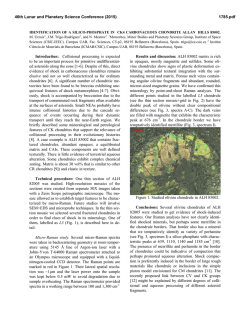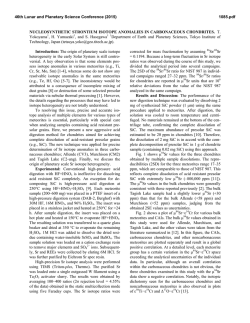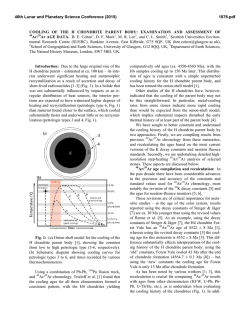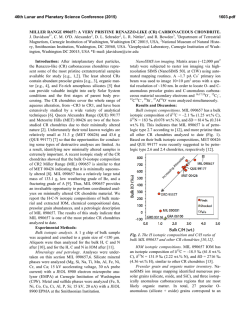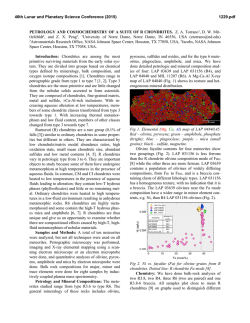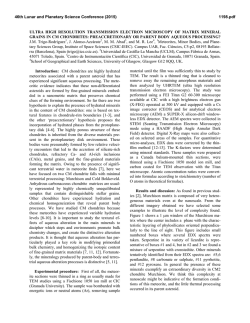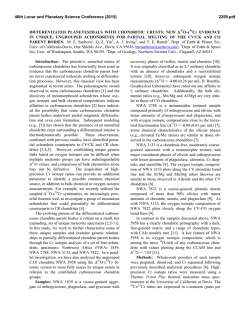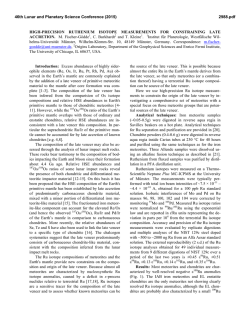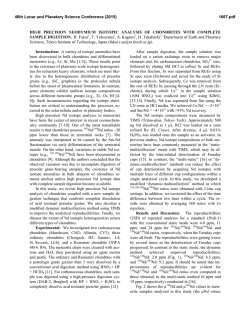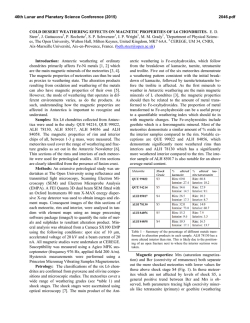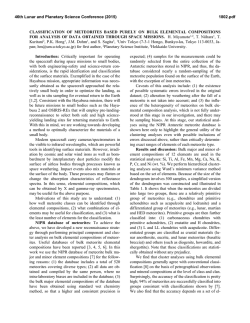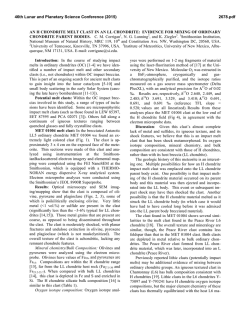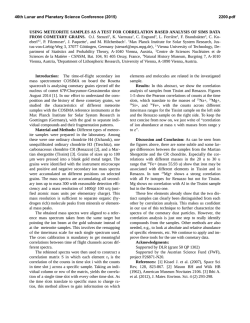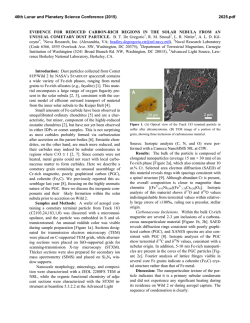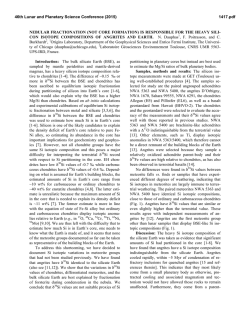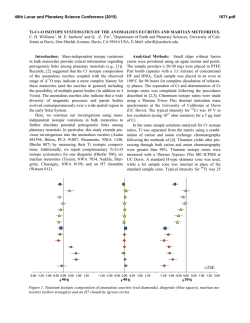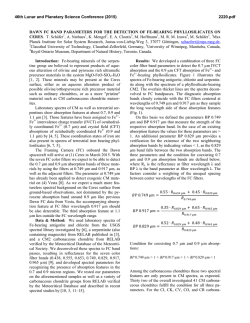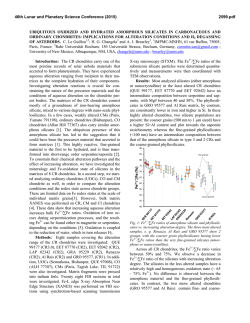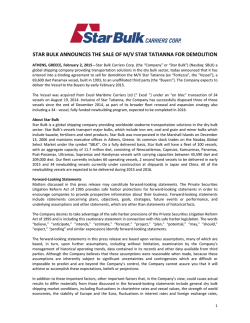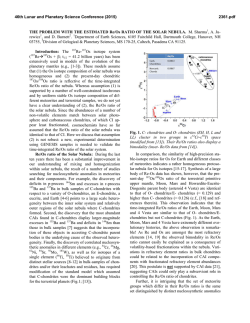
DIFFERENCES WITHIN CARBONACEOUS CHONDRITE GROUPS
46th Lunar and Planetary Science Conference (2015) 1122.pdf DIFFERENCES WITHIN CARBONACEOUS CHONDRITE GROUPS FROM A COMPARATIVE ICP-MS BULK CHEMISTRY. M. Martínez-Jiménez1, J.M. Trigo-Rodríguez1, and J. Alonso-Azcárate2. 1Meteorites, Minor Bodies, and Planetary Sciences Group, Institute of Space Sciences (CSIC-IEEC). Campus UAB, Fac. Ciències, C5-p2, 08193 Bellaterra (Barcelona), Spain ([email protected]), 2Universidad de Castilla-La Mancha (UCLM), Campus Fábrica de Armas, 45071 Toledo, Spain. ([email protected]). Introduction: Most chondritic meteorites, have never experienced prolonged metamorphism or strong heating, hence, they preserve much of the record of the formational processes that led to the origin of our solar system. Consequently, we expect that the bulk chemistry in the components of chondritic meteorites provide new clues about the physico-chemical conditions at work in the solar nebula and the Sun's circumstellar disk. Therefore, we are studying primitive meteorites with the hope to learn more about the formational processes that led to planet formation in our solar system. Due to the fact that most chondrite groups show similar characteristics, the most accepted theory of formation invokes the existence of multiple chondrule reservoirs with similar overall properties within the protoplanetary disk. This simplistic scenario is supported by isotopic and petrologic differences found in most chondrite groups [1]. We will focus here in carbonaceous chondrites (hereafter CCs) for several reasons, but basically because they are the oldest chondrites and they were stored in small asteroids consolidated in cooler external regions of the protoplanetary disc where organic matter and water ice managed to be present. With the aim of studying the bulk chemistry within the different CCs groups, we analysed by ICP-AES and ICPMS about 50 CCs in order to investigate the reasons of their bulk chemical differences. A direct comparison with the mean bulk elemental composition of recovered falls might inform us on the processes they suffered in the protoplanetary disc. With such a goal, in the current work we have analyzed some members representative of the CM, CO, CR, CV, CK, CH, and CI chondrite groups plus some ungrouped CCs. Experimental procedure: The samples were analyzed by an ICP-AES (Inductively coupled plasma atomic emission spectroscopy) ICAP 6500 Thermo Electron for major elements and an ICP-MS (Inductively coupled plasma mass spectrometry) Thermo Electron X Series II for minor and trace elements. Solutions were prepared from approximately 0.025 g of each sample. Four standard reference materials provided by the US Geological Survey were used for the preparation of external calibration curves. All the samples were fluxed with 0.05 g of Li-metaborate and dissolved in 30 ml HNO3 1N and 1 drop of HF. Results and discussion: In order to simplify the results, we did the mean for several samples belonging to each CC group (Table 1 and Figure 1). Group Meteorite names CH MET 01017; PCA 91467,36 CI C Orgueil CK ALH 85002; ALH 85002,90; LAR 04318; LAR 04318 2; LAR 04318,28; PCA 82500 1; PCA 82500 2 CM MIL 07689,5; SCO 06043,17; Cold Bokkeveld; EET 96029; LEW 87148; MAC 02606,10; Murchison; Murray; QUE 99355; QUE 99355,17 CO DOM 08006; MIL 03377; MIL 05024; ALHA7730; ALHA77307,149; Kainsaz; ALH 82101; ALH 82101,41; ALH 83108 1; ALH 83108 2; ALHA77003 1; ALHA77003 2 CR EET 92159; EET 92042; GRA 95229,105; LAP 02342; RBT 04133; RBT 04133 2 CV ALH 84028; ALH 84028,136; Allende; Leoville; MET 00430; MET 00430,31; MIL 07002; MIL 07002,18; QUE 99038,24; MET 01017 Table 1. Chondrites analyzed by alphabetical order. From our ICP-MS measurements we observe that the CHs exhibit the lowest Na abundance, with a large difference compared to other CCs. CHs are also strongly depleted in moderately volatile elements as Al, Mg, Si and Ti, consistent of having been processed by collisions [2]. On the other hand, the CM group shows low abundance in Na and K [3], which can be explained by a by-product of aqueous alteration, but it also has a lower mean abundance in Fe, Mg, Al, Si, P, and Ti. Besides, CM chondrites are famous for having finegrained high-density dust rims around chondrules [4] and all larger meteoritic constituents are surrounded by these dust rims, which can be explained by a compaction process [5]. CI shows a slightly higher abundance of Na, Mg, Si and Fe consistent of preserving the primordial solar composition. It can be also noticed that 46th Lunar and Planetary Science Conference (2015) the CI, CM, CO and CV groups have a larger set of refractory elements, being actually the CVs those that exhibit a highest abundance in refractory elements [6]. These bulk differences are probably suggesting different formation environments and evolutionary histories. Main elements 100 Mass (%) 10 1 Na Mg Al Si P K Ca Ti Fe 0,1 0,01 Elements Figure 1. Main rock-forming elements in carbonaceous chondrite groups analyzed here. On the other side, CCs ungrouped, which represent material coming from other parent bodies, are scarcely represented in our terrestrial collections but they remarkably show clear compositional differences compared to other carbonaceous chondrites. Just for example, clear differences are noticeable in the plot Mg vs. Fe (Figure 2), where values from several ungrouped CCs differ significantly compared to the rest of chondrite groups. 25,00 CCs ungro CI Mg wt (%) 20,00 CMs 15,00 CRs COs 10,00 CVs 5,00 CHs CKs 0,00 0,00 5,00 10,00 15,00 20,00 Fe wt (%) 25,00 30,00 35,00 40,00 Figure 2. Mg wt (%) vs. Fe wt (%) within the different carbonaceous chondrite groups. Conclusions: Chondrites exemplify the diversity of components and mixtures available at the early solar system, and seems paradoxal that all planets in the solar system share a common origin from that material. Morbidelli et al. recently summarized growth models 1122.pdf for planetesimal formation and concluded that chondrites formed at different distances from the Sun, depending on the typical abundance of water in their group [7]. Therefore, they sample a region in the protoplanetary disc, and the processes they suffered changed their bulk chemistry during their life. For instance, high-velocity collisions occurred regularly during the planetesimal-formation process and were dependant of heliocentric distance so that their impact on the porosity evolution of the growing planetesimals is a factor to be considered as well [2,5,9]. The peculiar evolutionary history of the parent of each chondrite group, but also that of the asteroidal fragments produced has also played a role in the final bulk chemistry of each chondrite. Some groups are revealed to be not pristine at all, and could come from secondary bodies accreted after colossal collisions. It could explain, for example, the lowest abundance in Na, as well as the depletion in moderately Al, Mg Si and Ti found in our data for the CH group. Moreover, it is thought that aqueous alteration has particularly played a key role in some CC groups in modifying their primordial bulk chemistry, and homogenizing the isotopic content of fine-grained matrix materials [3, 8-10] as happens in CMs which therefore are poor in Na and K. Acknowledgements: We thank Johnson Space Science curators for providing the Antarctic chips of the CCs analyzed here. Financial support from the Spanish MEC (research project AYA2011-26522) is also acknowledged. References: [1] Rhian H. J. (2012) Meteoritics & Planet. Sci. 47, Nr 7, 1176. [2] Beitz E. et al. (2013) Icarus 225, 558. [3] Rubin A.E. et al., (2007). Geochim. Cosmochim. Acta 71, 2361. [4] Metzler K., Bischoff A., and Stöffler D. (1992). Geochimica and Cosmochimica Acta 5. 2873. [5] Trigo-Rodriguez J.M. et al., (2006). Geochim. Cosmochim. Acta 70, 1271. [6] Wasson J. T. (1985). Meteorites: their record of early solar-system history. Publisher, W.H. Freeman. [7] Morbidelli, A., et al. (2012). Annu. Rev. Earth Planet. Sci. 40, 251. [8] Bland P. et al. (2006) Meteorites and the Early Solar System II, D.S. Lauretta & H.Y. McSween Jr. (eds.), Univ. Arizona Press, Tucson, 853. [9] Trigo-Rodríguez J.M., and J. Blum (2009) Publ. Astron. Soc. Australia 26, 289. [10] AlonsoAzcárate J. et al. (2014) LPS XLV, Abstract #1735.
© Copyright 2025
